What Is Negative Space in Drawing
You might have wondered what is a negative space drawing. We hear it here and there, especially in art classes. But sometimes it's hard to understand. I've always felt that way when someone would try to explain it to me. I needed images, visual examples to actually understand it and apply to my work.
What is a negative space drawing? It's when you draw the space around an object. Instead of directly drawing your main focus, you draw what's around it! Most of the times, it's the background.
Again, I feel that this is better understood with the help of visual examples. So let's talk a bit more about what negative space drawing is and why it's important to learn about it, along with some examples and even simple ideas for you to start practicing!
Why You Should Do Negative Space Drawings
Negative Drawing is where you draw the negative space of an object. For example, instead of drawing the chair in front of you, you're drawing the space around it. In the end, the shape of the chair will appear in the white space you left on the paper.
As opposed to contour drawing, where you focus on the lines and the contour of an object, here you focus on masses. You draw or paint big masses around the object you want to portrait, with different values.
In a negative drawing, value also plays a big part, since it's with it that we create depth and perspective in a piece. Let's see an example:
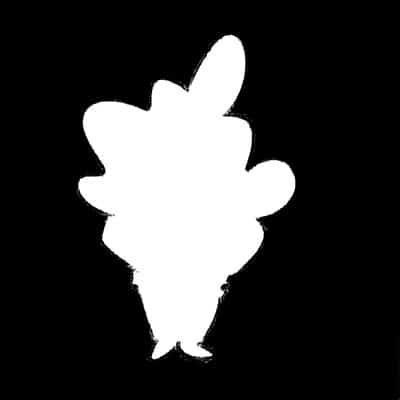
As you can see, I drew my character by drawing around it. Even though it's very simple, you can still recognize the small, cute mascot of this blog. The white is the positive space!
We make a negative drawing by finding the shapes around our object. Now you might've noticed in other posts or even in my courses, that I always advise finding the shapes of the object or subject you're drawing. In a negative drawing, the concept is the same, except we're looking for the shapes outside of that object!
The only rule here is that you can't draw the outline of your object first and then the space around it. That defeats the purpose of negative drawing and negative space.
It is important to draw negative space drawings for two reasons: by drawing the area around the object, you're creating a foundation for your drawing.
When you're finished with the negative space, you'll notice that you have a perfect outline and shape of the object you want to draw. After that, you just need to add the details inside of it.
The second reason is if you tend to work better with shapes and masses than lines. This kind of exercise can be really helpful for you if lines aren't your deal.
I find that some artists prefer to work with lines, while others start their drawings by painting big, irregular shapes that form their drawing and then work from there. I'm the first type, what about you?
It's important to try different exercises not only to learn but to also understand what works better for us. We do not do everything the same way. Find what you like the most and work your art from there!
Negative And Positive Shapes
The positive shape of a drawing is the primary subject of it, the main focus of the drawing.
In other words, it will probably be the place where you want the viewer's eyes to look first. Negative shape refers to the area around it, for example, the background.
A lot of times we work with both negative and positive shapes without even noticing. But creating a piece of art with these ideas in mind can create amazing and very balanced pieces of art.
A lot of times we work with both negative and positive shapes without even noticing.
It is very common to see the use of negative and positive space to create optical illusions! Take for example Rubin's Vase! A concept developed by the Danish psychologist Edgar Rubin, where a visual effect is present to the viewer, with two possible interpretations.
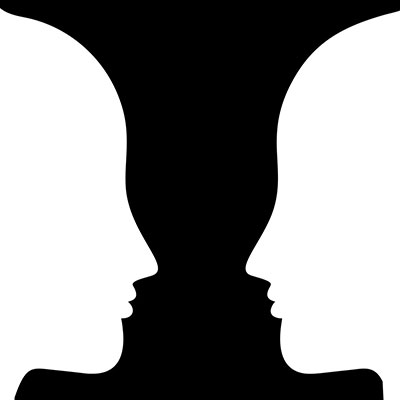
These visual effects are created by making use of negative and positive shapes. You can not see both these representations at the same time though, our eyes will either adjust to one or the other, depending on if you're focusing on the negative shapes or the positive ones.
I find this quite interesting, especially when it's applied to art! It can create very beautiful but also thoughtful pieces. These will make you want to look at them, finding all the details and see what more can you find in them!
One of my favorite artists, M.C Escher, actually played with this concept a lot and some of his most famous works are known for it. Escher worked a lot with optical illusion as well as with negative space.
Some more detailed and complex negative space drawings than others, but let's see a few examples below!
Negative Space Drawing Examples
If you read some of my other posts, it comes to no surprise that I really enjoy Escher's works. There's quite a lot of examples from him that I wanted to show here. Let's see a few:
This is a very good example of negative and positive space being used in the art.
We notice the change of subject, not only through the shapes but also the transition from black to white. It's almost a twist on the Rubin's Vase, except you can transition from one subject through the other. We are transported from water to air with the use of negative space and value.
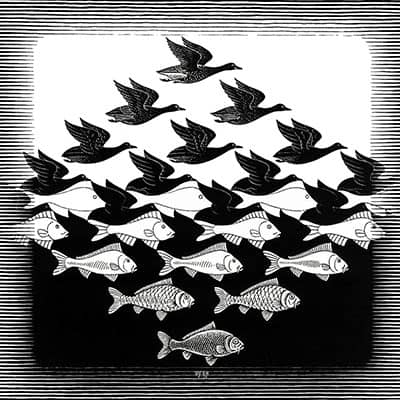
A bit more complex, but we can still notice how much negative space takes importance here.
The leaves are drawn mostly by drawing the space around them. They do have details in them, but you can immediately tell what they are, by simply looking to the shape that the negative space creates!
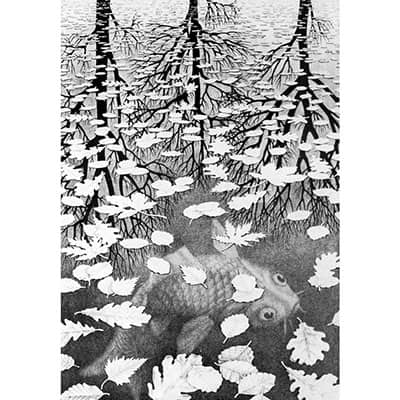
Very similar to the first example, but I added this one mainly to point out that you don't necessarily need to make a negative space drawing by using black and white only. Feel free to experiment with color as well!
Be creative with negative space drawing! Again, this can be something that is part of your own artistic style. Use negative space to envoke the idea of something. At first glance, that object isn't really there, but you can see it because of what is drawn around it.
Feel free to experiment with color as well!
Take the example of Kei Megure and their 'Bikini Babes' series! The swimsuits are a focus on these drawings, but they're not directly drawn. They're visible through the bodies that were drawn instead!
Remember that a negative space drawing can be as complex or as simple as you want. It can be patterns and shapes, but it can also be animals, plants, people and others. It can have color, be made in black and white or both!
Here are two more examples by tattoo artists Martynas Šnioka
And Victor J Webster
Negative Space Drawing Assignments And Ideas
If you're interested in trying your hand at negative space drawing, but don't know where to start, then I got you! You can do these drawings with almost anything and, most of the times, you have what you need at home! Let's see some ideas to start drawing negative space drawing:
- Plants and Flowers! I'll be very honest here, drawings plants, in general, are quite hard for me. But negative space drawing is actually great to learn how to draw them and to simplify the process. Start with very simple plants, with no flowers and big leaves. If you have plants at home, grab the vase and put it right in front of a window where the sun is shining. This way, the sun will hit the plant and you'll see it mostly as a big shape. Now just draw what you see! You can also look for pictures online, on Pinterest for example or go for a walk in a garden and draw the plants you encounter.
- Vases, mugs, goblets, and glasses. Certainly, you have a few of these at home, pick them up and draw them. If it makes it easier for you, take photos, convert them to black and white or grayscale. Now you just need to draw what you see on the photo. Remember that what you're drawing here is the space around the object! Otherwise, it's not negative space anymore. Again, you can also look for pictures online and use them as a
reference . - Silhouettes of animals and people. Don't worry about details just yet. Take pictures of yourself in different poses. Take photos of people while you're at the cafe or somewhere else. Look for pictures online, SenshiStock's
deviantart page is a great place to look for any kind of poses! The same applies to animals, take photos of your pets or find some online. Draw their silhouettes in different poses. Just a simple background and a white silhouette. As you get more confident try to add more details! - Chairs and stools. Again this is something we have at home and they make great models for negative space drawing. Put them against a white wall or against the sun. Draw them!
I highly recommend using the light of your home or a clean background like a wall when starting negative space drawings. It makes it easier to understand the shape of the object and how to draw it.
You can also take pictures or grab images from the internet, convert them to black and white or even crop the background.
The most important is to understand the shape you're drawing. This is the first step. If the background has too much happening, it makes it harder for you to distinguish the object from the background. Start simple and grow from there!
Related Questions
Is negative space the background? Negative space is usually used as a neutral background, to strengthen the main focus of the piece. But this is not always the case. Take the example of Kei Megure's work shown above. There's background, there's a body that was drawn (negative shapes) and finally the positive shapes created by it!
What is the difference between negative and positive space? Positive space is the focus of the drawing, what you want your viewers to look at, while negative space is the space around it.
What is negative space photography? Also called white space, negative space in photography serves to give breathing room to a picture. If a picture as too many things going on, it becomes too cluttered and the viewer doesn't know where to focus. It works very similarly as in drawing, but here you're capturing the scene by taking a photo of it.
Back to the Blog
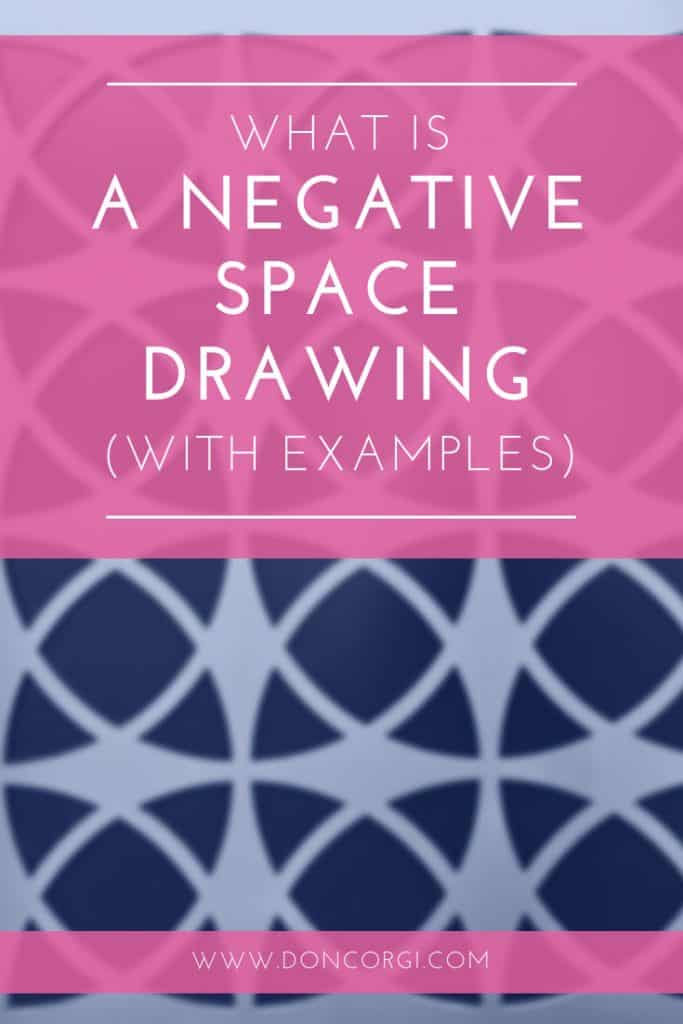
Source: https://doncorgi.com/blog/negative-space-drawing/
0 Response to "What Is Negative Space in Drawing"
Post a Comment